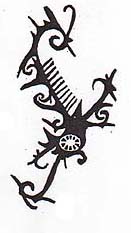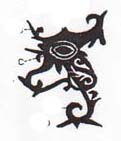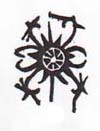Lipan katip
Jump to navigation
Jump to search
The Kenyah are one of the many tribes of Borneo that had a strong tattoo tradition. Unfortunately, we only have a few examples of it from the Sarawak Museum.
 Urang, also known as the "prawn pattern" is a modification of the dog design. |
 Toyu is a crab design. From a tatu block in the Sarawak Museum (No. 1054-71) |
 The lipan katip is a design of the claws of a centipede, and is intended for the breast or shoulder of a man. From a tatu block in the Sarawak Museum. (No. 1054-20) |